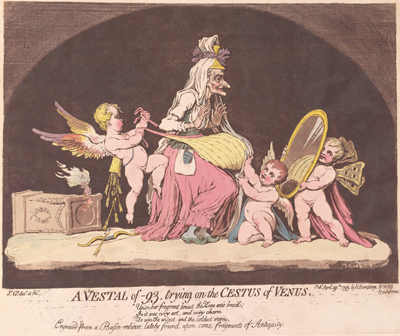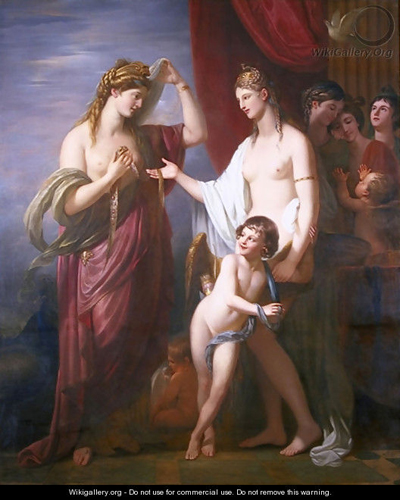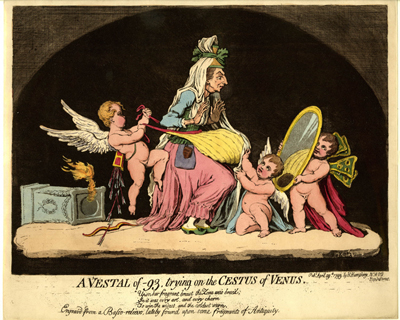A Vestal of -93, Trying on the Cestus of Venus
Like Gillray's earlier La Belle Assemblée (1787), this is a scathing portrait of the vanity of older women, but (in this case) it is also a satire on the latest absurd fashion of wearing "belly pads" under a dress to achieve a more attractive and Grecian-looking figure.* Beginning with the title, a number of visual and verbal allusions to classical culture helps to sharpen Gillray's pointed attack.

© Beinecke Rare Book and Manuscript Library, Yale University
In Roman religion, a "vestal" was one of six young women sworn to chastity who were dedicated to the goddess of the hearth and whose duties included maintaining an eternal flame in the temple of Vesta. But Gillray's "Vestal of -93" is neither young nor (likely) chaste. She is old and hag-like, and, behind her, the altar of Vesta with its flame has already been overturned. Indeed with a copy of Ovid in her pocket (most likely the Ars Amatoria), and the cestus of Venus around her waist, she is clearly "on the make."
In Homer's Iliad, the cestus of Venus is a magic band or zone that gives to the wearer all those seductive powers and capabilities that we associate with the goddess of love. It is mentioned in Book XIV of Alexander Pope's translation where Juno convinces Venus to loan it to her to better seduce her husband Jove. It is from this larger passage (quoted below) that Gillray borrows (and slightly adapts) the three lines that appear on the print.
With Awe divine the Queen of Love
Obey'd the Sister and the Wife of Jove:
And from her fragrant Breast the Zone unbrac'd,
With various Skill and high Embroid'ry grac'd.
In this was ev'ry Art, and ev'ry Charm,
To win the wisest, and the coldest warm:
Fond Love, the gentle Vow, the gay Desire,
The kind Deceit, the still-reviving Fire,
Persuasive Speech, and more persuasive Sighs,
Silence that spoke, and Eloquence of Eyes.
This on her Hand the Cyprian Goddess lay'd;
Take this, and with it all thy Wish, she said:
With Smiles [Juno] took the Charm; and smiling prest
The pow'rful Cestus to her snowy Breast. (Book XIV 243—256)
But this is no Juno and this is no cestus of Venus. This is simply an ugly old woman who is deluded enough to believe that a belly-pad will make all the difference in her love life.
The subject of Juno receiving the Cestus of Venus had been alluded to in Joshua Reynolds' Mrs Blake as Juno Receiving the Cestus of Venus in 1769. It appeared more directly in Juno Receiving the Cestus from Venus (1771) by Benjamin West, and in a print by W. Wynne Ryland Juno borrowing the Cestus from Venus (c. 1782), so if he hadn't been aware of it through Pope's translation of the Iliad, Gillray would have had several opportunities to see the story portrayed.

Juno Receiving the Cestus from Venus
[1771]
© Wikigallery.org
But in all of these other productions, the emphasis is upon the exchange between Venus and Juno. In Gillray's version the exchange has already taken place; the supposed "Vestal of -93" is trying on the cestus, gazing into the mirror to see how she looks. This places Gillray's print not in the line of history paintings derived from the Cestus episode in Homer but rather in the tradition of Venus with a Mirror by Titian, Rubens, and others, focusing on the critique of vanity embodied such rapt mirror-gazing. And once again we are very aware that this is no Venus gazing at the mirror held by putti, but an ugly old hag. And as Cupid's entire arsenal of arrows falls to the ground while he is trying to tie the cestus, we can guess that the wished-for amorous conquests will never take place.
Gillray created two versions of this print, both dated April 29, 1793. One version, likely the first one, featured a generic hag with the witch-like features we have seen above. But Gillray seems to have quickly changed his mind and substituted the face of Lady Cecilia Johnston for the generic old hag. Why?

© Trustees of the British Museum
Lady Cecilia was one of Gillray's favorite targets. With her distinctive profile, she was the subject of one of Gillray's first and earliest portrait caricatures, appearing in 1780. Two years later, her nick-name among her aristocratic friends (St. Cecilia), and her reputation as an amateur musician, earned her a second appearance in Gillray's wonderful parody of Reynold's famous portrait of Mrs Sheridan as St. Cecilia. And, of course, Lady Cecilia was one of the older society women specifically satirized in La Belle Assemblée (1787) for her continued devotion to the rites of love and beauty. But most recently, in February of 1792, Gillray had portrayed her in The Power of Beauty. St. Cecilia Charming the Brute, or The Seduction of the Welch Ambassador where the implication of an extra-marital affair is no longer generic and theoretical, but specific and actual. So adding the visage of Lady Cecilia to the ironic image of a "vestal of -93" determined to find a sexual partner gave the print a further grounding in reality.
* For a thorough and excellent discussion of this fad, see Amelia Rauser's article linked below.
Sources and Reading
- Commentary from the British Museum on Vestal of -93, Trying on the Cestus of Venus.
- "Vestal Virgin," Wikipedia
- "Ovid," Wikipedia
- Amelila Rauser, "Vitalist Statues and the Belly Pad of 1793," Journal 18
- Thomas Wright and R.H. Evans, Historical and Descriptive Account of the Caricatures of James Gillray #394
- Thomas Wright and Joseph Grego, The Works of James Gillray, the Caricaturist; With the History of His Life and Times, p. 175
Comments & Corrections
NOTE: Comments and/or corrections are always appreciated. To make that easier, I have included a form below that you can use. I promise never to share any of the info provided without your express permission.